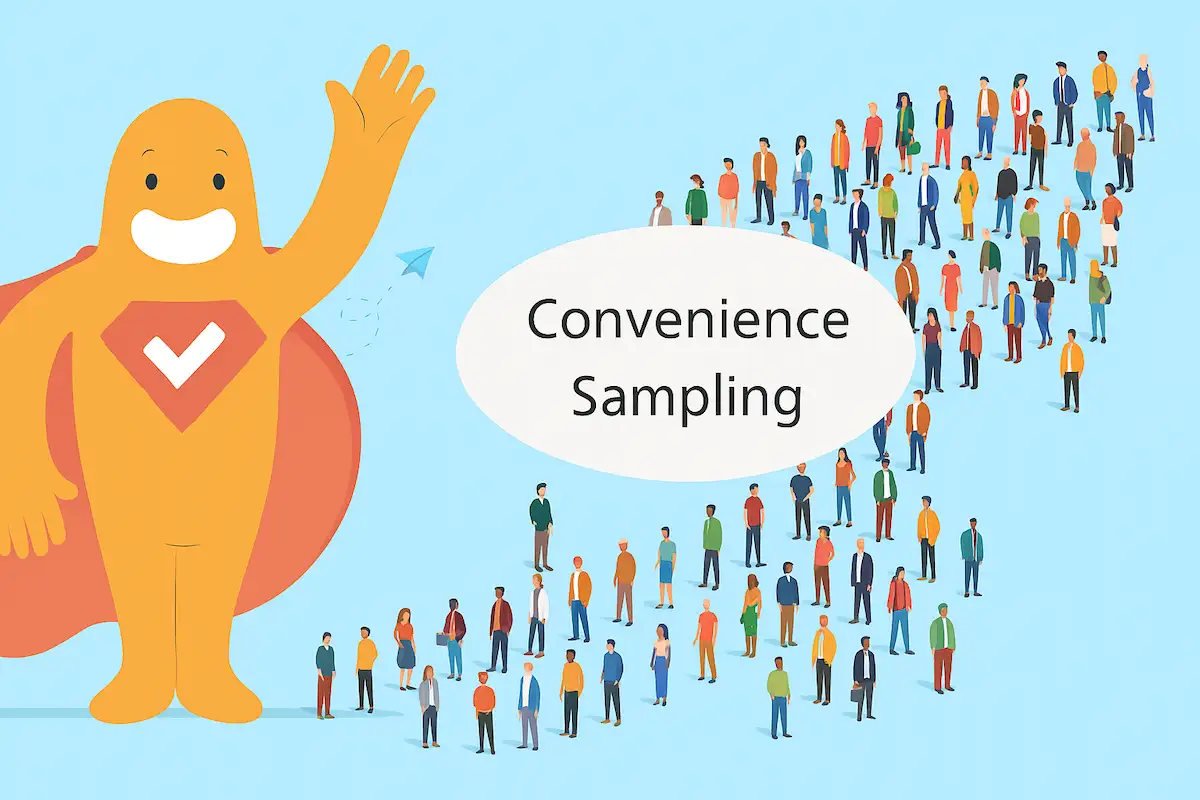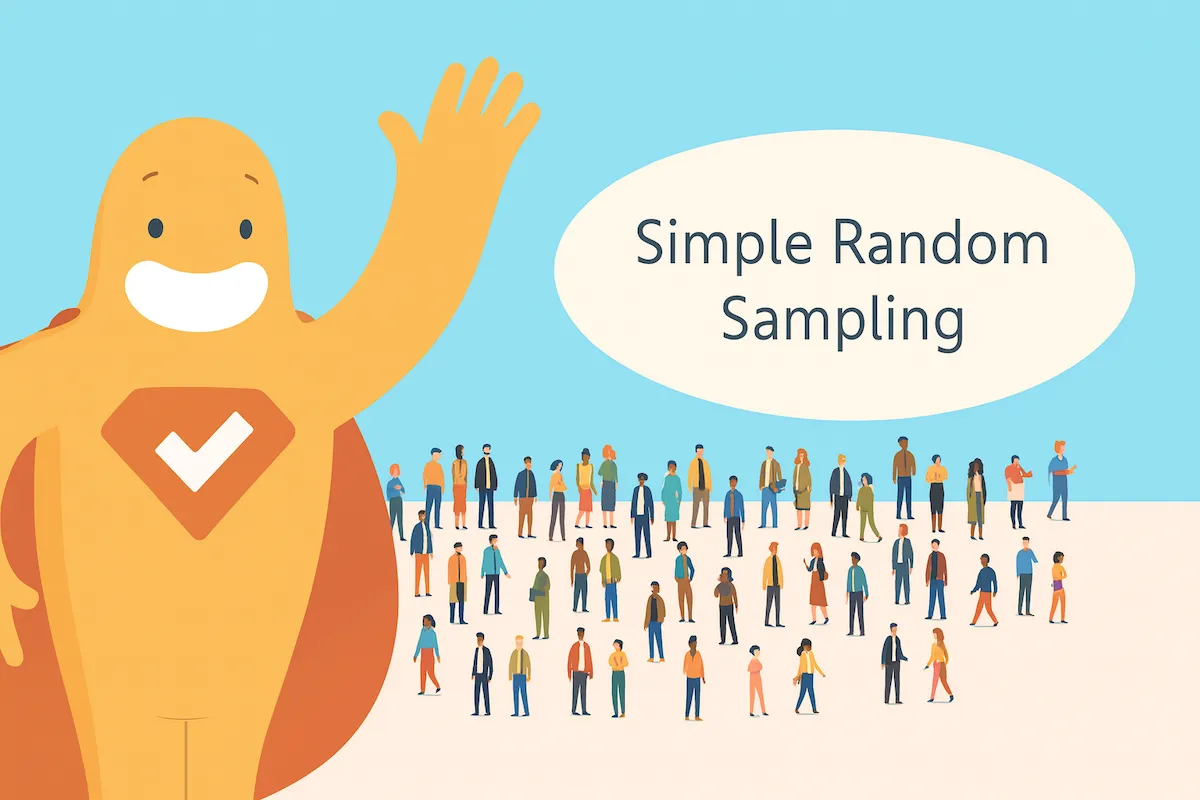Convenience sampling is a non-probability sampling method that collects data from respondents who are easily accessible to the researcher. Also called accidental or availability sampling, it’s fast, inexpensive, and ideal for exploratory research or pilot studies. However, because it doesn’t use random selection, results may be biased and not representative of the population. Common examples include surveying nearby students, customers leaving a store, or online users. While convenience sampling offers speed and simplicity, its lack of accuracy limits generalizability. Researchers can minimize bias by using online surveys, combining multiple samples, or applying mixed methods for more reliable insights.
Create your FREE Convenience Sampling Survey, Poll, or Questionnaire now!
Many surveys are concerned with people’s age, gender, income, education level, and other demographic information. These surveys want to know this information because they’re targeting a specific portion of the population. On the other hand, some surveys aren’t concerned with any specifics other than proximity to the researcher. These “down and dirty” surveys use the convenience sampling method. There are a number of advantages to convenience sampling, but also some disadvantages. Let’s dive in!
Convenience Sampling Definition
The convenience sampling method involves collecting data from a conveniently available pool of respondents. Convenience sampling is also known as accidental sampling and availability sampling, and is a sample-based approach. There are no criteria required to be included in the sample, and it does not matter if the sample is representative of the entire population; everyone is eligible. Convenience sampling is a type of non-probability sampling method, and is often used when a defined sampling frame is unavailable. Unlike random sampling, which uses random selection to achieve a representative and unbiased sample, convenience sampling does not ensure representativeness. With the sample readily available and no specific audience in mind, this sampling technique is chosen for its practicality and speed, making convenience sampling quick, easy, and inexpensive. Of course, there are problems with convenience sampling, which we’ll highlight shortly.
Create your FREE Convenience Sampling Survey, Poll, or Questionnaire now!
Convenience Sampling Examples
Here are examples of convenience sampling in action. To better understand the convenience sampling method, it helps to look at some examples. Here are four examples of convenience sampling research.
-
A student is researching the typical alcohol consumption of college students. He surveys all the students in his dorm and asks them how often they drink alcohol and how much they drink. Of course, those living in dorms may be less likely to drink as much as those living off campus, so his sample may not be representative of all college students, introducing bias, but those surveyed are located conveniently to him for his survey.
-
A business wants feedback on a new product offering. They survey people as they leave the store to get their feedback on the new product. This is an example of grab sampling, where participants are selected as they become available. While they’re only surveying people who may have been interested in the product in the first place, introducing bias since they were already in the store, it was a convenient way to capture feedback for further research.
-
An online platform for teens wants to know how often a user is likely to participate in a discussion. The site doesn’t require membership information, so there is no way to drill down to specifics (age, gender, location, etc). Instead, the site deploys random pop-up surveys to 300 users. This could involve a short survey to quickly gather feedback. While these users may not represent the majority of users, they were conveniently accessible to reach out to through the website.
-
A news outlet wants to know which presidential candidate most people are likely to vote for. So, they survey people in person on the street at a busy intersection. Here, the researchers are recruiting participants in a public setting for survey research. There may be a lot of bias (the city does not represent the country as a whole, after all, and could be a very red or blue location), but the participants were conveniently accessible to the researcher.
-
A researcher is conducting a qualitative research study on mental health among college students. To recruit participants, the researcher uses convenience sampling by selecting students who visit the campus counseling center. This allows for quick and easy recruiting of participants, but the collected samples may not represent the broader student population.
With convenience sampling, the collected samples are often biased and may not be generalizable to the entire population, which is a key limitation of this method.
Create your FREE Convenience Sampling Survey, Poll, or Questionnaire now!
Other Types of Convenience Sampling
Within the realm of convenience sampling, there are two other types of sampling.
-
Consecutive sampling. While samples are still chosen based on convenience, there’s not a set number of participants. Instead, the goal is to conclude. So, each survey is analyzed once it’s complete before administering the next survey. Once the researcher has a conclusive result, the survey ends.
-
Self-selective sampling (aka volunteer sampling). This sampling method uses volunteers to reach the desired sample size. People sign up to be part of the survey often because there is an incentive involved. For example, medical research studies may offer financial compensation or free trials of a particular drug that could benefit someone with a particular condition.
Another non-probability sampling technique is purposive sampling, where researchers deliberately select participants based on their judgment and prior knowledge about who will be most relevant to the study’s purpose. This sampling technique is useful when specific expertise or characteristics are required from participants, and it contrasts with convenience sampling, which relies mainly on accessibility.
Snowball sampling is another sampling technique often used alongside convenience sampling, especially when researchers need to reach hard-to-access or specialized populations. In snowball sampling, initial participants refer others who meet the study criteria, helping to expand the sample’s reach and diversity.
Create your FREE Convenience Sampling Survey, Poll, or Questionnaire now!
Advantages of Convenience Sampling
Many researchers choose convenience sampling for its practicality and speed.
Convenience sampling research has many benefits, which make it a popular choice for researchers. Using convenience sampling allows you to quickly gather preliminary data for further research, making it ideal when time or resources are limited. Using convenience sampling is especially beneficial in exploratory or pilot studies, where fast and accessible data collection is needed. Here are five pros of convenience sampling.
1. Fast Data Collection
When time is an issue, convenience sampling offers a quick way to collect data. Because there are no demographic specifics or any other set of “rules,” convenience sampling can be conducted quickly, reaching out to anyone in proximity or anyone online.
Create your FREE Convenience Sampling Survey, Poll, or Questionnaire now!
2. Inexpensive Data Collection
Researchers may spend a lot of money on other types of sampling methods because they are focusing on specific demographics. Finding a target audience and marketing to them can be expensive versus simply surveying anyone within your proximity. Students, startups, and small businesses with limited funds often turn to convenience sampling.
3. Easy Data Collection
Because the researcher is only surveying people within his or her proximity, data collection is easy (as discussed within the previous examples above). By simply surveying those near, quotas can quickly be met, and data collection time can be reduced.
Create your FREE Convenience Sampling Survey, Poll, or Questionnaire now!
4. Fewer (or No) Rules
Most surveys have “rules,” i.e., a checklist of who their target audience is. With convenience sampling, data collection doesn’t follow any rules; the researcher isn’t seeking out a specific audience. So, they don’t need to worry about age, gender, race, or any other demographic questions.
5. Hypothesis Formation Assistance
Convenience sampling is very important when it comes to exploratory research. Some researchers use convenience sampling as a first step to form hypotheses. After forming a hypothesis based on convenience sampling, they may then spend the additional time and money on a different type of sampling method to get a clearer picture.
Create your FREE Convenience Sampling Survey, Poll, or Questionnaire now!
Drawbacks of Convenience Sampling
There are several disadvantages of convenience sampling that researchers should be aware of, especially when considering the limitations of this research method. Here are the problems with the convenience sampling technique:
-
Because the sample was not chosen randomly, but rather through a survey of those in proximity, the sample will never be fully representative of the population being studied. The convenience sampling technique, including availability sampling, is prone to bias and a lack of representativeness.
-
The accuracy of data collected can be compromised since only easily contacted participants are reached. Using convenience sampling may limit the collection of relevant data for a research project.
-
Conclusions rely on the subjective judgment of the researcher and the subjective motivations of the participants, leading to further survey bias.
-
Researchers may be subjective in how they choose their participants (e.g., by stopping the passersby who appear friendliest), causing additional survey bias.
While convenience sampling and availability sampling are useful for pilot studies or exploratory research projects, they may not be suitable for a full-scale research project that requires more robust research methods to ensure reliable and generalizable results.
Create your FREE Convenience Sampling Survey, Poll, or Questionnaire now!
Reducing Survey Bias in Convenience Sampling
The best way to reduce bias in convenience sampling is by conducting an online survey. With an online survey, researchers aren’t limited to those in proximity; they can easily survey people around the country and the world to come to better, more accurate conclusions. In addition, many online survey programs offer advanced statistical tools that can be used to analyze survey data to determine validity, reliability, and statistical significance. Be sure to read our blog on the 14 Advantages of Online Surveys. And, just because we’re an online survey company, it doesn’t mean we don’t recognize some of the disadvantages. We address those in the blog, too!
Create your FREE Convenience Sampling Survey, Poll, or Questionnaire now!
Convenience Sampling with Online Image Surveys
Just because convenience sampling is “convenient,” doesn’t mean that you’ll get the responses you need. To improve your response rates, consider using a different method or use online surveys with photos. Our picture surveys boost engagement, help trigger respondent emotion and memory, and cross language barriers. They’re ideal when going about this type of sampling!
Below is an example of a convenience sampling survey with images for a school. It’s convenient because the researcher is only asking questions of those within their school, and the imagery helps make it more engaging for respondents.

Create your FREE Convenience Sampling Survey, Poll, or Questionnaire now!
How to Analyze Convenience Sampling Data
Analyzing convenience sampling data requires a thoughtful approach, especially since this non-probability sampling method can introduce sampling bias and sample bias. Because convenience samples are not drawn randomly, the data collected may not accurately reflect the entire population. However, with the right steps, you can still extract valuable insights and use convenience sampling as a powerful tool for gathering preliminary data, pilot testing, or informing future research.
Here’s how to effectively analyze convenience sampling data:
-
Clean and Organize Your Data: Start by ensuring your data is accurate, complete, and well-structured. Remove duplicates, check for missing responses, and organize demographic data to make the analysis process smoother.
-
Conduct Descriptive Statistics: Use summary statistics—such as means, medians, and standard deviations—to get a clear picture of your sample’s characteristics. This is especially useful for both qualitative and quantitative questions, helping you understand the basic trends within your convenience sample.
-
Identify and Address Potential Biases: Recognize that convenience sampling data may be affected by sampling bias or sample bias. Document any limitations in your sampling methodology, and consider how these biases might influence your research findings.
-
Combine Qualitative and Quantitative Questions: By including both qualitative data answers and quantitative questions in your survey, you can gain a more comprehensive understanding of your topic. Qualitative insights can add context to the numbers, while quantitative data allows for easier comparison and trend analysis.
-
Visualize with Trend Analysis Graphs: Use trend analysis graphs and other visual tools to spot patterns or shifts in your data. Visualizations can make it easier to communicate findings and identify areas for deeper investigation.
-
Interpret Findings with Caution: Since convenience sampling does not use probability sampling techniques, avoid making broad generalizations to a larger population. Instead, focus on the trends and insights that are specific to your sample, and clearly state the limitations of your sampling method in your reporting.
-
Consider Multiple Samples or Mixed Methods: To strengthen your research, consider collecting multiple samples or combining convenience sampling with other sampling methods, such as quota sampling, stratified sampling, or systematic sampling. This can help reduce sampling error and increase the validity of your research findings.
Create your FREE Convenience Sampling Survey, Poll, or Questionnaire now!
By following these steps, you can analyze convenience sampling data more effectively, even with the inherent limitations of this non-probability sampling method. While convenience sampling may not always provide a representative sample, it is a valuable approach for quick data collection, pilot data collection, and gathering initial insights in market research, medical research, and social sciences.
For more advanced analysis, researchers can explore integrating probability sampling or other representative sampling methods in future research projects. This helps reduce bias in convenience sampling and ensures that your research findings are more robust and applicable to the target population.
Create your FREE Convenience Sampling Survey, Poll, or Questionnaire now!
Remember, the key to making convenience sampling work is to be transparent about its limitations, use it strategically for preliminary data, and always look for ways to improve your sampling methodology for future studies.
Convenience Sampling with Online Image Surveys
Just because convenience sampling is “convenient,” doesn’t mean that you’ll get the responses you need. To improve your response rates, consider using a different method or using online surveys with photos. Our picture surveys boost engagement, help trigger respondent emotion and memory, and cross language barriers. They’re ideal when going about this type of sampling!
Below is an example of a convenience sampling survey with images for a school. It’s convenient because the researcher is only asking questions of those within their school, and the imagery helps make it more engaging for respondents.
Create your FREE Convenience Sampling Survey, Poll, or Questionnaire now!
Conclusion
Convenience sampling is a go-to method of research for those looking to conduct quick, cheap, and easy surveys. While this approach has some drawbacks, it’s also a great way to get started on a survey that will inform bigger future ambitions. A convenience survey can provide some initial data on which to create and conduct a survey with a more thorough segment of the population. Be sure to check out our blog 8 Types of Survey Sampling + Pros & Cons, Errors & Bias, and More. Of course, however you want to conduct your survey, we’ve got you covered. SurveyLegend lets you start for free and has dozens of beautiful and responsive templates from which to choose.
What types of sampling methods do you use when surveying? Which provides the best results? Let us know in the comments!
Create your FREE Convenience Sampling Survey, Poll, or Questionnaire now!
Frequently Asked Questions (FAQs)
What is convenience sampling?
Convenience sampling means collecting data from a “conveniently available” pool of respondents. Everyone is eligible; they must just be within easy reach of the surveyor.
Why should you use convenience sampling?
Convenience sampling is usually used when funds are lacking; surveyors can simply present questionnaires to those near them, regardless of demographic data.
Is convenience sampling biased?
It can be. Because convenience sampling only looks at a small subset of the population, it may not be reflective of the greater population.
Is there a good way to conduct convenience sampling?
Using an online survey is ideal for preventing common convenience sampling drawbacks, as it can cast a wide net, which provides a more accurate picture of the situation.



